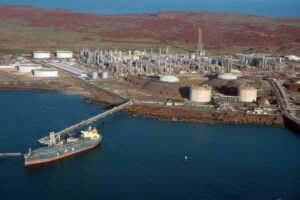New research from the CSIRO, produced in collaboration with the Australian gas industry, has found that fugitive emissions from Australian Liquified Natural Gas production are at the ‘low end’ of the scale, and suggest Australian gas “may” result in less greenhouse gas emissions than coal use.
However, questions remain over the contributions of Australian gas to global emissions.
The report released by the CSIRO draws upon commercial-in-confidence data provided by a coal-seam gas to LNG plant in the Surat Basin in Queensland and has undertaken a comprehensive assessment of the life-cycle emissions of Australian LNG exports.
The report was produced by the CSIRO’s Gas Industry Social and Environmental Research Alliance (GISERA), which is a partnership between the CSIRO and the gas industry, including Australia Pacific LNG, QGC, Santos and Origin Energy, and has received funding from the NSW South Australian governments.
The findings of the report have been leapt upon by gas lobby group APPEA, claiming the report show’s the positive contribution being made by the Australian gas industry towards lowering emissions. The report was leaked to The Australian and the Australian Financial Review newspapers.
The CSIRO estimates “fugitive emissions” at the project were around 1.4 per cent, which is crucially below the threshold of 3 per cent which represents the point where fugitive emissions eliminate the benefits of lower the emissions intensity of natural gas compared to that of coal.
However, in releasing the report, the CSIRO has echoed questionable assertions made by Federal Energy minister Angus Taylor, who has claimed that rising Australian greenhouse gas emissions, driven higher by the expansion of Australia’s LNG industry, can be ignored because that gas is being used to reduce emissions overseas by offsetting coal use.
Taylor is using a line that has previously been used by fossil fuel giant Woodside Petroleum, and has claimed that Australian gas exports reduced global emissions by 148 Mt CO2-e in 2018, but provided no evidence to substantiate the figure.
But it is also a proposition that has been questioned by other experts in Australian energy policy and economics, who have said that it is ‘silly’ to simply assume that Australian gas exports would be entirely displacing coal use overseas.
The Australian National University’s Frank Jotzo said as much in The Conversation, questioning the claims from Taylor that Australia should be credited with emissions reductions as a result of increasing LNG exports that have pushed Australia’s own emissions higher.
“In truth, the assumption that every unit of Australia’s exported gas displaces coal is silly. The claim of a 148Mt saving is wrong and unfounded. The real number would be much smaller, and there could even be an increase in emissions as a result of LNG exports,” Jotzo said.
“For the most part, exported gas probably displaces natural gas that would otherwise be produced elsewhere, leaving overall emissions roughly the same. Some smaller share may displace coal. But it could just as easily displace renewable or nuclear energy, in which case Australian gas exports would increase global emissions, not reduce them.”
The Australia Institute rightly compared the claims about LNG emissions to those of ‘low-tar’ cigarettes. Just because a product is ‘not the worst’ for your health, or the environment, doesn’t mean that it is without harm.
“Just as ‘low tar’ cigarettes were aimed at keeping people smoking, WA’s big gas export companies use the claim that gas is “low emissions” relative to coal, in order to justify continuing exporting massive amounts of Liquefied Natural Gas (LNG) for decades to come. But in reality, gas is only less emissions-intensive than coal if you ignore a large chunk of its emissions,” The Australia Institute researcher Mark Ogge said.
To this point, the CSIRO was unable to confirm whether Australian gas was having a positive impact on global emission, as it was unable to determine whether the gas exported from Australia was displacing the use of coal.
“In the present study, we cannot calculate directly the GHG emissions reduction of LNG exports from Curtis Island, Queensland, relative to coal-fired electricity generation in Asia because we do not know the proportion of gas used to displace what would have been produced from coal,” the report said.
The CSIRO report estimated that the emissions intensity of natural gas used for electricity production would vary between 0.73 T.CO2-e/MWh if used an open-cycle gas turbine and 0.53 T.CO2-e/MWh when used in a more efficiency combined-cycle gas turbine. This result can be either good or bad, depending on what your point of comparison is.
These emissions intensities for gas generation are around half that achieved by coal generators, but they are substantially higher than was is effectively emissions-free electricity produced by wind and solar.
“These results are consistent with other CSIRO studies in this region which suggest that the fugitive emissions component of the total greenhouse gas emissions identified in this latest study are at the lower end of the scale,” the CSIRO’s Dr Damian Barrett said.
“The climate benefits of using natural gas in place of thermal coal for electricity generation are generally accepted when fugitive emissions are less than three per cent of total production.”
“Replacement of coal-fired power by gas-fired generation, renewables and other low-carbon technologies is part of CSIRO’s vision for Australia’s energy transition.”
“Results of this latest research underline the potential climate benefits of using gas in place of coal to generate electricity, particularly when using high efficiency closed cycle gas turbines,” Barrett added.
So, if Australia’s fugitive gas emissions remain consistent with current levels, and if exported Australian gas is used in high-efficiency gas generators, and if that electricity displaces generation that otherwise would have come from coal, then perhaps Australian gas can contribute to lowering global emissions.
That’s a lot of ‘ifs’, and unfortunately, neither Angus Taylor nor the CSIRO has presented any solid evidence to substantiate claims that Australian gas exports are indeed reducing global emissions.








